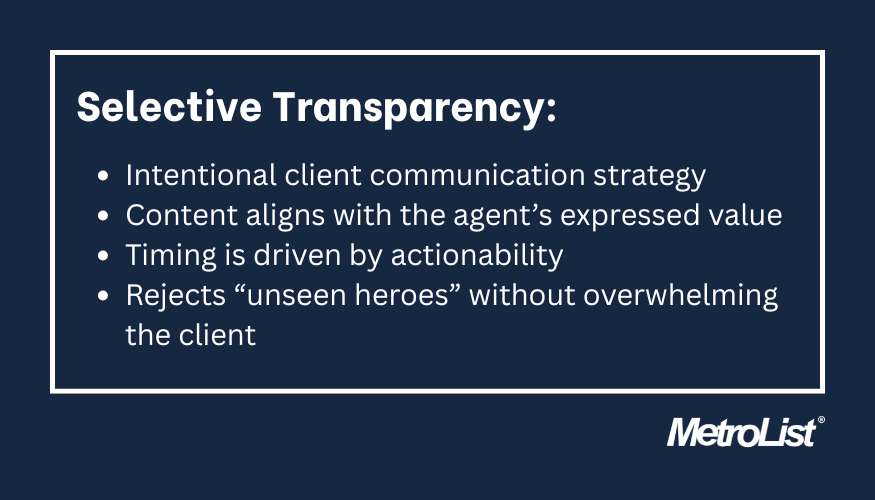Real Estate’s Catch-22: Balance Visibility with Value
Written by John Hughes, VP of Industry Relations
In real estate, agents often measure success by how effortless the process feels to the client. After all, service industries are primarily driven by client experience, and home buyers and sellers dream of a transaction where everything falls into place seamlessly. However, making a transaction look “too easy” can quickly make a dangerous transition in the mind of the consumer to “Why do I need this agent in the first place?” It turns out, selective transparency is the key to the riddle.
What the Client Sees vs. What They Don’t
In any transaction, there are many types of information scenarios:
- Direct – information that the client experiences directly, such as loan qualification or inspections.
- Indirect / Actionable – information relayed by the agent that necessitates a preventative or reactive decision.
- Indirect / Delayed – notable information that requires no immediate action and may best be shared after close.
- Indirect / Unnecessary – Stressor information that is both non-actionable and builds no value.

Some agents hide too much of what they do, unintentionally reinforcing the myth that the job is easy. Others overcompensate by dramatizing everyday bumps to engineer a heroic “save.” Neither approach benefits the client’s perception or the profession.
The smarter path is selective transparency – an intentional communication strategy that prioritizes topics of foresight and skill, properly times the release of information with regard to a client’s ability to act on it, all without burdening the client with every granular detail or, worse yet, manufacturing unnecessary drama.
Experience + Reliable Tools = Consistently High Performance
Value isn’t just about rescuing a deal when something goes wrong. Many of the biggest wins are invisible because they are preventative. A skilled agent communicates proactively with lenders to avoid surprise financing issues, engages inspectors early to prevent minor concerns from spiraling into deal-breakers, and leverages trusted networks of professionals to smooth out processes before clients ever feel a bump. Just as importantly, they build an effective relationship with the agent on the other side, collectively eliminating potential deal barriers or even bridging the shortcomings of the other agent when necessary.
This expertise deserves to be shared, not in the form of alarms or fire drills, but as part of an ongoing education process:
- Market Education – Helping clients understand conditions, competition, and timing.
- Transaction Education – Showing how all the moving pieces fit together.
- Professional Networking – Unveiling the extended team of resources used to ensure the transaction is handled at an exceptional level.
- Risk Education – Highlighting the pitfalls buyers and sellers may mitigate or outright avoid through proactive planning and contractual terms.
- Protection Against Mistakes – Demonstrating how experience and skill act as the ultimate insurance policy against a bad, life-changing decision.
However, knowing the “right equation” to use in any scenario still isn’t effective without having the right information. This is where the MLS has an agent’s back. Agents should not be shy about educating their clients that the MLS data is the most accurate and up-to-date to be found anywhere, including consumer portals. The agent serves as a gateway to a vast array of professional-level data, not only providing reliable sales information but also linking and providing context with other critical information sets, such as neighborhood, tax, rental, and ADU feasibility, just to name a few.
Consistent high performance can’t be achieved without both expertise and reliable information. Clients should be informed how they are being set up with the best opportunity for success. Without an agent, the “easy” transaction perpetuated by reality TV can quickly turn into the most expensive and stressful decision of a lifetime.
From Invisible to Indispensable
In the end, the goal isn’t invisibility — it’s credibility. The most effective professionals are not those who operate in total silence, nor those who overplay hurdles, but those who communicate just enough for clients to fully grasp the orchestration behind their successful outcome.

Agents who strike this balance develop stronger relationships, inspire referrals, and elevate the reputation of the industry as a whole. Most importantly, they protect their clients’ peace of mind while reminding them, through thoughtful communication and outreach, that the seamless transaction they experienced was no accident.
